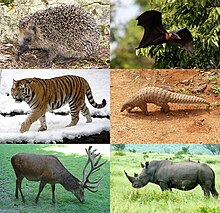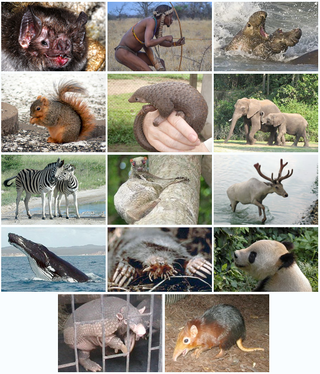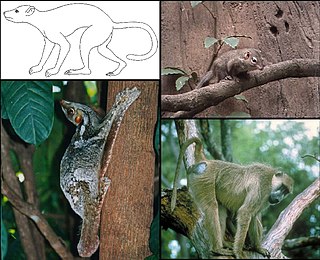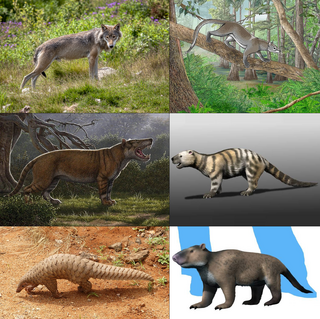Boreoeutheria
| Boreoeutheria | |||||||||||
|---|---|---|---|---|---|---|---|---|---|---|---|
 | |||||||||||
 | |||||||||||
| Biyolojik sınıflandırma | |||||||||||
| |||||||||||
| Üst takımlar | |||||||||||
| Sinonimler | |||||||||||
| |||||||||||
Boreoeutheria (Boreotheria ile eşanlamlıdır; Eski Yunanca Βορέας, Boreas 'kuzey rüzgarı, Kuzey', εὐ-, eu- 'iyi, doğru' ve θηρίον, thēríon 'canavar'. Dolayısıyla: 'gerçek kuzey canavarları'), plasentalı memelilerin bir kladıdır (bir magna takım). Grup iki kardeş taksondan oluşur: Laurasiatheria ve Euarchontoglires.
Bu gruba ait bilinen en eski fosiller, yaklaşık 65 milyon yıl öncesine, yani Kretase-Tersiyer yok olma olayından kısa bir süre sonrasına aittir, ancak moleküler veriler daha erken, Geç Kretase döneminde ortaya çıkmış olabileceklerini göstermektedir. Kladdaki erkek hayvanlarda bir skrotum bulunur.[a][4][5] Alt klad Scrotifera bu özelliğin adını almıştır.[6]
Boreoeutherian atası
Boreoeutherianların ortak atası 100 ile 90 milyon yıl önce arasında yaşamıştır. Boreoeutherian atası, zürafalar, köpekler, fareler, yarasalar, balinalar ve insanlar gibi çeşitli türlere yol açmıştır. Boreoeutherian atası kavramı ilk olarak 2004 yılında Genome Research dergisinde önerildi.[7][8] Makalenin yazarları, boreoeutherian atalarının genom dizisinin %98 doğrulukla hesaplamalı olarak tahmin edilebileceğini, ancak "birkaç yıl ve çok para alacağını" iddia etti. Üç milyar baz çift içerdiği tahmin ediliyor. Diğer araştırmalar, ortak atayı 65 milyon yıl öncesine daha yakın bir yere yerleştirdi.[9]
Sınıflandırma
- Magna takım: Boreoeutheria
- Üst takım: Euarchontoglires
- Büyük takım: Euarchonta
- Takım: Scandentia (sivri sincapçıklar)
- Mir takım: Primatomorpha
- Takım: Dermoptera (uçan lemurlar veya colugolar)
- Takım: Primatlar (primatlar)
- Büyük takım: Glires
- Takım: Lagomorpha(pikalar, tavşanlar, tavşanlar)
- Takım: Rodentia (kemirgenler)
- Büyük takım: Euarchonta
- Üst takım: Laurasiatheria
- Takım: Eulipotyphla (gerçek böcek öldürücüler)
- Klad : Scrotifera
- Takım: Chiroptera (yarasalar)
- Büyük takım: Ferungulata
- Mir takım: Ferae (Etçiller, pangolinler ve "kreodontlar")
- Klad : Pan-Euungulata
- Mir takım: Euungulata (gerçek toynaklılar)
- Aile: † Protungulatidae
- Üst takım: Euarchontoglires
Kladogram
Boreoeutheria kladogramındaki filogenetik ilişkileri gösteren kladogram.[10][11]
| Placentalia |
| ||||||||||||||||||||||||||||||
Notlar
- ^ Erkeklerde normal boreoeutherian skrotumdan yoksun olan istisnai soylar, köstebekler, kirpiler, pangolinler, bazı foklar ve morslar, gergedanlar, tapirler, su aygırı ve deniz memelileridir.
Kaynakça
- ^ Zhou, Xuming; Xu, Shixia; Xu, Junxiao; Chen, Bingyao; Zhou, Kaiya; Yang, Guang (7 Ağustos 2011). "Phylogenomic Analysis Resolves the Interordinal Relationships and Rapid Diversification of the Laurasiatherian Mammals". Systematic Biology. 61 (1): 150. doi:10.1093/sysbio/syr089. ISSN 1076-836X. PMC 3243735 $2. PMID 21900649.
- ^ "PBDB". paleobiodb.org. 11 Haziran 2021 tarihinde kaynağından arşivlendi. Erişim tarihi: 11 Temmuz 2021.
- ^ Arnason U., Adegoke J. A., Gullberg A., Harley E. H., Janke A., Kullberg M. (2008.) "Mitogenomic relationships of placental mammals and molecular estimates of their divergences." Gene.; 421(1-2):37–51
- ^ The Encyclopedia of Applied Animal Behaviour and Welfare. CABI. 2010. ss. 293-. ISBN 978-0-85199-724-7. 28 Haziran 2021 tarihinde kaynağından arşivlendi. Erişim tarihi: 20 Haziran 2019.
- ^ "Why are testicles kept in a vulnerable dangling sac?". slate.com. 8 Temmuz 2013. 9 Temmuz 2013 tarihinde kaynağından arşivlendi.
Between these branches, however, is where it gets interesting, for there are numerous groups, our descended but a-scrotal cousins, whose testes drop down away from the kidneys but don't exit the abdomen. Almost certainly, these animals evolved from ancestors whose testes were external, which means at some point they backtracked ... , evolving anew gonads inside the abdomen. They are a ragtag bunch including hedgehogs, moles, rhinos and tapirs, hippopotamuses, dolphins and whales, some seals and walruses, and scaly anteaters.
- ^ Waddell (1999). "Using novel phylogenetic methods to evaluate mammalian mtDNA, including amino acid-invariant sites-LogDet plus site stripping, to detect internal conflicts in the data, with special reference to the positions of hedgehog, armadillo, and elephant". Systematic Biology. 48 (1): 31-53. doi:10.1080/106351599260427. PMID 12078643.
The name comes from the word scrotum a pouch in which the testes permanently reside in the adult male. All members of the group have a postpenile scrotum, often prominently displayed, except for some aquatic forms and pangolins (which have the testes just below the skin). It appears to be an ancestral character for this group, yet other orders generally lack this as an ancestral feature, with the probable exception of Primates.
- ^ "Scientists recreate genome of ancient human ancestor". National Geographic. 25 Ocak 2005. 21 Mart 2006 tarihinde kaynağından arşivlendi. Erişim tarihi: 14 Şubat 2015.
- ^ Mathieu Blanchette (2004). "Reconstructing large regions of an ancestral mammalian genome in silico". Genome Research. 14 (12): 2412-2423. doi:10.1101/gr.2800104. PMC 534665 $2. PMID 15574820.
- ^ "Scientists recreate genome of ancient human ancestor". MNN. 15 Şubat 2013. 13 Şubat 2018 tarihinde kaynağından arşivlendi. Erişim tarihi: 16 Nisan 2019.
- ^ Foley, Nicole M.; Springer, Mark S.; Teeling, Emma C. (19 July 2016). "Mammal madness: Is the mammal tree of life not yet resolved?". Philosophical Transactions of the Royal Society B. 371 (1699): 20150140. doi:10.1098/rstb.2015.0140. ISSN 0962-8436. PMC 4920340 $2. PMID 27325836.
- ^ Esselstyn, Jacob A.; Oliveros, Carl H.; Swanson, Mark T.; Faircloth, Brant C. (26 Ağustos 2017). "Investigating Difficult Nodes in the Placental Mammal Tree with Expanded Taxon Sampling and Thousands of Ultraconserved Elements". Genome Biology and Evolution (İngilizce). 9 (9): 2308-2321. doi:10.1093/gbe/evx168. ISSN 1759-6653. PMC 5604124 $2. PMID 28934378.
Ek Kaynaklar
- Waddell (2001). "A phylogenetic foundation for comparative mammalian genomics". Genome Inform Ser Workshop Genome Inform. 12: 141-154. PMID 11791233.
- Murphy (2001). "Resolution of the early placental mammal radiation using Bayesian phylogenetics". Science. 294 (5550): 2348-2351. doi:10.1126/science.1067179. PMID 11743200.
- Kriegs (2006). "Retroposed elements as archives for the evolutionary history of placental mammals". PLOS Biology. 4 (4): e91. doi:10.1371/journal.pbio.0040091. PMC 1395351 $2. PMID 16515367.
- Blanchette (Dec 2004). "Reconstructing large regions of an ancestral mammalian genome in silico". Genome Research. 14 (12): 2412-2423. doi:10.1101/gr.2800104. PMC 534665 $2. PMID 15574820.
- Ma (Dec 2006). "Reconstructing contiguous regions of an ancestral genome". Genome Research. 16 (12): 1557-1565. doi:10.1101/gr.5383506. PMC 1665639 $2. PMID 16983148.
- Gross (14 Mart 2006). "Resolving the family tree of placental mammals". PLOS Biology. 4 (4): e111. doi:10.1371/journal.pbio.0040111. PMC 1395350 $2. PMID 20076552.
Dış bağlantılar
 Wikimedia Commons'ta Boreoeutheria ile ilgili çoklu ortam belgeleri bulunur
Wikimedia Commons'ta Boreoeutheria ile ilgili çoklu ortam belgeleri bulunur Vikitür'de Boreoeutheria ile ilgili ayrıntılı taksonomik bilgiler bulunur.
Vikitür'de Boreoeutheria ile ilgili ayrıntılı taksonomik bilgiler bulunur.- Olson (April 2006). "Bringing back the brontosaurus". Wired. 20 Ekim 2012 tarihinde kaynağından arşivlendi. Erişim tarihi: 28 Haziran 2021.



















